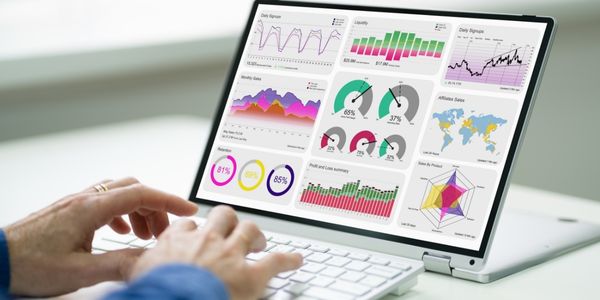How To Become a Data Analyst
05/22/2025

In the ever-evolving data analytics industry, data analysts play a key role in turning raw data into actionable insights.
If you're wondering how to become a data analyst, this guide explores essential skills, educational paths, and ways to gain practical experience.
The Growing Demand for Data Analysts
The role of a data analyst has gained significance in recent years as organizations increasingly rely on data analysis to inform decisions, improve operations, and gain a competitive edge. Whether in healthcare, finance, or marketing, the demand for skilled data professionals is high. The data analytics field continues to grow, with the Bureau of Labor Statistics projecting a 36% growth1 from 2023-2033.
The need for data analysts spans various roles, from entry-level data analysts to positions like business intelligence analysts and data scientists. Whether you aim to perform data analysis or work with data mining, the skills you develop may prepare you for a wide range of data analyst roles.
Educational Pathways and the Foundation of Your Data Analyst Career
A formal degree in computer science, data science, or statistics may be a strong starting point for building the technical skills necessary for a data analyst career. Rasmussen University's online Bachelor's Degree in Data Analytics2 offers a well-rounded curriculum that covers essential topics such as data manipulation, statistical analysis, and data visualization. As a student, you'll use tools like Tableau®, Microsoft Azure® and Excel®, and languages such as SQL®, R® and Python® to visualize data.
Courses prepare you to compile large amounts of data from various sources and develop actionable insights to help business leaders and their organizations.
Alternative Learning Paths: Online Courses and Bootcamps
There are several online courses and bootcamps that offer intensive training in data analysis. These courses can help you develop the data analytics skills needed to work with data sets, unstructured data, and data analysis tools. Look for data analysis competitions or projects that allow you to practice skills like data cleaning, data preparation, and data visualization.
Bootcamps like General Assembly® and Springboard® provide focused training for those who want to learn quickly and gain hands-on experience in a short period of time. Some of these programs also focus on domain knowledge, which can be helpful in specific industries such as marketing or healthcare.
Technical Skills Development: Mastering Technical Tools
To analyze data, you’ll need a set of essential data analysis skills and tools3. Here are some common technical skills data analysts may use in their day-to-day work:
Programming Languages
As a data analyst, programming languages such as SQL®, Python®, and R® are important for tasks like data manipulation, data cleaning, and conducting statistical analysis. These languages help you organize, analyze, and visualize complex data sets. For example, SQL® is essential for querying databases, while Python® and R® allow for more advanced statistical operations and machine learning tasks.
Data Visualization Tools
Once you’ve collected data and conducted statistical analysis, the next step is to visualize data to make insights clear and accessible. Proficiency in data visualization tools like Tableau®, Power BI®, and Excel® may allow you to present findings effectively. Good data visualization is an important skill, as it helps to communicate insights to non-technical stakeholders.
Statistical Concepts and Techniques
Understanding statistical concepts is central to performing meaningful data analysis. Key skills in statistical analysis will help you interpret data and extract useful patterns from data assets. You’ll need to be familiar with techniques like exploratory data analysis, hypothesis testing, and regression analysis.
How To Become a Data Analyst Through Practical Experience
While formal education and online courses are important, aspiring data analysts may also find that practical experience might help develop the analytical skills needed for the job. Here’s how to do that:
Work on Real-World Data Analysis Projects
Hands-on experience with data analysis projects is valuable. You can start by analyzing publicly available data sets or work on projects in areas that interest you. Gaining real-world experience may add to your data analytics skills but also allow you to practice key techniques such as data cleaning, data manipulation, and data mining.
Internships and Freelance Opportunities
If you’re just starting out, look for internships or freelance opportunities where you can contribute to data analysis projects. Internships can provide exposure to the data analysis process and allow you to learn from experienced data professionals.
Build a Portfolio To Showcase Your Data Analysis Skills
Building a strong portfolio is key to demonstrating your data analytics skills to potential employers. Here are a few ways to create a portfolio:
- Real-world projects: Use publicly available datasets (like on Kaggle® or government portals) to perform data analysis and create meaningful insights. Focus on showcasing data cleaning, statistical analysis, and visualization skills.
- Data competitions: Join challenges on platforms like Kaggle® to work on real-world problems, refine your skills, and gain exposure to advanced techniques like machine learning.
- Data visualizations: Build interactive dashboards or charts using tools like Tableau® or Power BI®. Show how you can transform complex data into actionable insights.
- Open-source projects: Collaborate on GitHub® to contribute to data-related projects, demonstrating your coding skills and ability to work in teams.
- Document your work: For each project, clearly explain your approach, including data preparation, exploratory data analysis (EDA), and final insights. Providing context for your work is as important as the results.
Certifications and Continuous Learning
The data analytics industry is constantly changing, so it's important to keep learning and stay up-to-date with the latest tools and techniques.
Certifications
Consider earning industry-recognized certifications such as the Google Data Analytics Professional Certificate, Microsoft Certified: Data Analyst Associate, or Certified Analytics Professional (CAP). These certifications help validate your proficiency in the data analysis process and may help you stand out in a competitive job market.
Ongoing Learning
The world of data analytics is dynamic, with new techniques and technologies emerging regularly. Participate in data analysis competitions, attend webinars, and practice coding skills to stay competitive in the data science field. Platforms like Kaggle® offer opportunities to work on real-world data analysis projects and participate in challenges that help you grow your skills.
Soft Skills: Communication and Problem-Solving
In addition to technical proficiency, data analysts need soft skills4 such as effective communication and problem-solving. As a data analyst, you’ll be responsible for interpreting complex data and conveying insights to stakeholders. Being able to communicate clearly and effectively may come in use when doing business with non-technical stakeholders and when collaborating with other team members. Problem-solving skills will also help you navigate challenges in the data analysis process and find solutions when faced with data integrity or data quality issues.
Job Search Strategies: Finding Your First Data Analyst Job
Once you're ready to start the job search, consider these tips:
- Tailor your resume: Highlight your data analysis skills, programming skills, and any relevant certifications. Showcase projects where you analyzed data and demonstrated your ability to work with data visualization tools and data manipulation techniques.
- Network: Join online communities, attend data analytics events, and connect with data professionals on LinkedIn®. Networking can help you learn more about the industry and discover job openings.
- Prepare for interviews: Brush up on your understanding of statistical concepts, programming languages, and data analysis tools. Be prepared to talk about the data analysis projects you’ve worked on and your approach to things.
Your Path To Becoming a Data Analyst
To become a data analyst, you’ll need a combination of technical skills, practical experience, and continuous learning. Whether you're learning through a formal degree, online courses, or self-study, building a strong foundation in data analysis can help you pursue opportunities within the data analytics field.
As the data analytics industry continues to grow, there will be many opportunities for individuals with the right skills to contribute to organizations' data-driven decisions. Start developing your data skills today and pursue a rewarding career where you can help organizations make informed choices based on data analysis.
Are you ready to become a data analyst? Explore programs like the Data Analytics degree2 at Rasmussen University and take the first step toward checking out more opportunities in data analytics.
Tableau® is a registered trademark of Salesforce.com, Inc.
Microsoft Azure® is a registered trademark of Microsoft Corporation.
Excel® is a registered trademark of Microsoft Corporation.
SQL® is a registered trademark of Oracle Corporation.
R® is a registered trademark of the R Foundation.
Python® is a registered trademark of the Python Software Foundation.
General Assembly® is a registered trademark of General Assembly Space, Inc.
Springboard® is a registered trademark of SlideRule Labs, Inc.
Kaggle® is a registered trademark of Google LLC.
GitHub® is a registered trademark of GitHub, Inc.
LinkedIn® is a registered trademark of LinkedIn Corporation.
1Bureau of Labor Statistics, U.S. Department of Labor, Occupational Outlook Handbook, Data Scientists, at https://www.bls.gov/ooh/math/data-scientists.htm#tab-6 (visited Mar. 25, 2025).
2Rasmussen University, Data Analytics Degree Program, at https://www.rasmussen.edu/degrees/technology/data-analytics/ (visited Mar. 25, 2025).
3Journal of the Society for Advancement of Management, California State Polytechnic University, Pomona, at https://www.csupom.com/uploads/1/1/4/8/114895679/v16n1p5.pdf (visited Mar. 25, 2025).
4Bureau of Labor Statistics, U.S. Department of Labor, Occupational Outlook Handbook, Data Scientists, at https://www.bls.gov/ooh/math/data-scientists.htm#tab-4 (visited Mar. 25, 2025).



